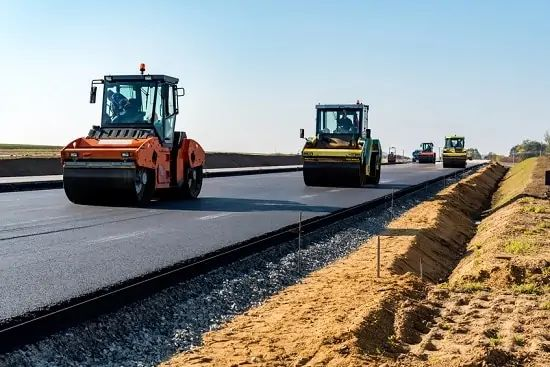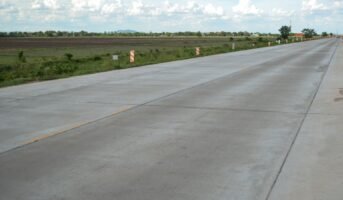Rigid pavement is a type of concrete pavement that is designed to provide durability, has a long lifespan, and has the ability to withstand heavy loads. It is commonly used for high-traffic roads, airports, and industrial areas, where the pavement needs to be able to handle a lot of wear and tear. The construction of rigid pavement typically involves pouring concrete slabs on top of a subgrade and base layer. The slabs are usually reinforced with steel or other materials to improve their strength and joints are used to allow for expansion and contraction due to changes in temperature. Joints can also help prevent cracking and other types of damage.
See also: Flexible pavement: Why is it popular in the construction industry?
Rigid pavement: Advantages
One of the advantages of rigid pavement is its low maintenance needs. While it does require some upkeep to ensure its longevity, it generally requires less maintenance than other types of pavements. Additionally, rigid pavements provide a smoother ride for drivers, which can improve safety and reduce wear and tear on vehicles. Its durability and long lifespan make it a cost-effective choice in the long run, and with proper maintenance and planning, it can provide a safe and reliable surface for many years to come.
Rigid pavement: Challenges
There are also some challenges associated with rigid pavement. One of the biggest challenges is cracking, which can occur due to temperature changes or heavy loads. Drainage issues can also cause erosion and other types of damage. Despite these challenges, rigid pavement remains a popular choice for many high-traffic areas.

Source: Pinterest
Rigid pavement: Components and their functions
Following are the various components of rigid pavements.
Prepared soil subgrade
- The soil subgrade of rigid pavement is made up of natural or specially chosen soil from designated borrow pits that satisfies the required specifications.
- The dirt subgrade has been properly compressed to achieve the correct density and thickness.
- The lowest layer of the pavement structure, the soil subgrade, is what eventually supports all subsequent pavement layers and traffic loads.
- The pavement has a long service life provided the soil subgrade is excellent, thoroughly compacted, and prepared.
Drainage layer (DL) or granular sub-base (GSB)
- To stop early failures caused by high moisture content in the subgrade soil, the GSB course must act as a reliable drainage layer of the rigid pavement.
- Aggregate made of crushed stone is preferable as it has a high level of permeability and acts as a reliable drainage layer.
- An excellent drainage layer will be made of coarse-graded aggregates with a low percentage of fines (5% finer than 75 micron sieve).
The advantages of having a good drainage layer beneath CC pavements include the following:
- CC pavements function better and have a longer service life.
- Preventing early inflexible pavement breakdowns from pumping and blowing.
- Protection of the subgrade from the effects of frost in places susceptible to frost.
Base course (Dry lean concrete)
- With low-traffic volume roads as well as on roads with moderate traffic loads, the granular base course is often installed beneath the CC pavement slab.
- It is desirable to use high-quality base course materials, such as dry lean concrete, for roads bearing heavy to extremely strong traffic loads.
- The CC pavement’s base course is made of materials that are intended to last 30 years or more with proper care. The CC pavement is stated to have a service life of at least 40 years.
- When laying the PQC slab with a sensor paver, the DLC layer offers homogeneous support, high K value, and an ideal operating platform.
- Before installing the CC pavement slab, the suppression member is laid on top of the DLC/base course.
CC pavement slab {Paving quality concrete (PQC)}
- The IRC advises using an M-40 cement concrete mix for CC-pavements on roads with heavy to extremely severe traffic loads, with a minimum flexural strength of 45 kg/cm2.
- The CC pavement slab is stretched to withstand the flexural stress brought on by the high traffic volumes and the impact of temperature fluctuations on warping in the CC pavements.
- The PQC slab of the CC pavement is built using a high-quality CC mix with strong flexural strength.
- The CC pavement slab has significant flexural strength and, through slab action, disperses the applied force and wheel loads across a broad area.
- The slab stops extra surface water from penetrating into the sub-base.
Rigid pavement: Structure

Source: Pinterest
Concrete slab
The topmost layer of rigid pavement that comes into direct contact with vehicle loads is a concrete slab. This also goes by the name surface course. Water cannot penetrate the base channel because of its water resistance. It provides the cars with friction to prevent skidding. The concrete slab’s thickness is restricted to 150 to 300 mm.
Granular base or stabilised base course
The second layer from the top, known variously as the base course, granular base, or stabilised base, is built using crushed aggregates. The surface course may take on more weight thanks to this course. It offers a solid foundation on which to build stiff pavement. The provision of a subsurface drainage system is also helpful. The stabilised base course can be used in frosty places to control the action of the frost. It aids in reducing subgrade soil swelling. The foundation course should be at least 100 mm thick.
Granular subbase or stabilised subbase course
It is the third layer down and comes into contact with the base course and subgrade soil. While they should be of higher quality than subgrade, it is created using aggregates of lower quality than the base course. In most cases, a subbase course is not necessary when there is little traffic. When the loading is greater than 100,000 pounds, it should be built. Its main job is to support the top layers, but it also controls frost action and keeps fines from the subgrade from getting into the top layers. A subbase course will also enhance drainage capability.
Frost protection layer
Frost activity on the pavements is an issue in areas with low temperatures. If the soil has a high groundwater table, the water will freeze during cold weather and frost heave will occur beneath the subgrade, raising the pavement as a result of the ice crystals’ irregular growth. Similar to how ice melts, when load is applied to pavement, it will pierce the subgrade. A protecting layer should be offered to avoid this frost. In most cases, a solid foundation course and subbase course provide layers of frost protection.
Subgrade soil
The existing soil layer, which is compacted using machinery to create a sturdy foundation for stiff pavement, makes up the subgrade. As the tensions decrease with depth, the subgrade soils are under less stress than the top layers. Subgrade soils can differ greatly. Different soils respond differently to forces emanating from the top layers. They may be resistant to some soils and not to others. It is dependent on the interactions between the subgrade’s texture, density, moisture content, and strength. Hence, before building, a subgrade inspection should be done properly. In order to minimise the displacement of subgrade soil layers, the pavement layers above the subgrade should be able to reduce pressures placed on the subgrade soil.
FAQs
What is the typical thickness of a rigid pavement slab?
The thickness of a rigid pavement slab varies depending on the anticipated traffic loads and the underlying soil conditions. Typically, it ranges from 7 to 12 inches.
What is joint spacing in rigid pavement?
Joint spacing in rigid pavement refers to the distance between the transverse and longitudinal joints that are cut into the concrete slab to control cracking. It typically ranges from 10 to 15 feet.
How are joints maintained in rigid pavement?
Joints in rigid pavement are typically maintained by sealing them with a joint sealant to prevent water and debris from entering and causing damage to the slab. Regular maintenance and repair of joints are important to extend the lifespan of the pavement.
| Got any questions or point of view on our article? We would love to hear from you.
Write to our Editor-in-Chief Jhumur Ghosh at [email protected] |
Housing News Desk is the news desk of leading online real estate portal, Housing.com. Housing News Desk focuses on a variety of topics such as real estate laws, taxes, current news, property trends, home loans, rentals, décor, green homes, home improvement, etc. The main objective of the news desk, is to cover the real estate sector from the perspective of providing information that is useful to the end-user.
Facebook: https://www.facebook.com/housing.com/
Twitter: https://twitter.com/Housing
Email: [email protected]












